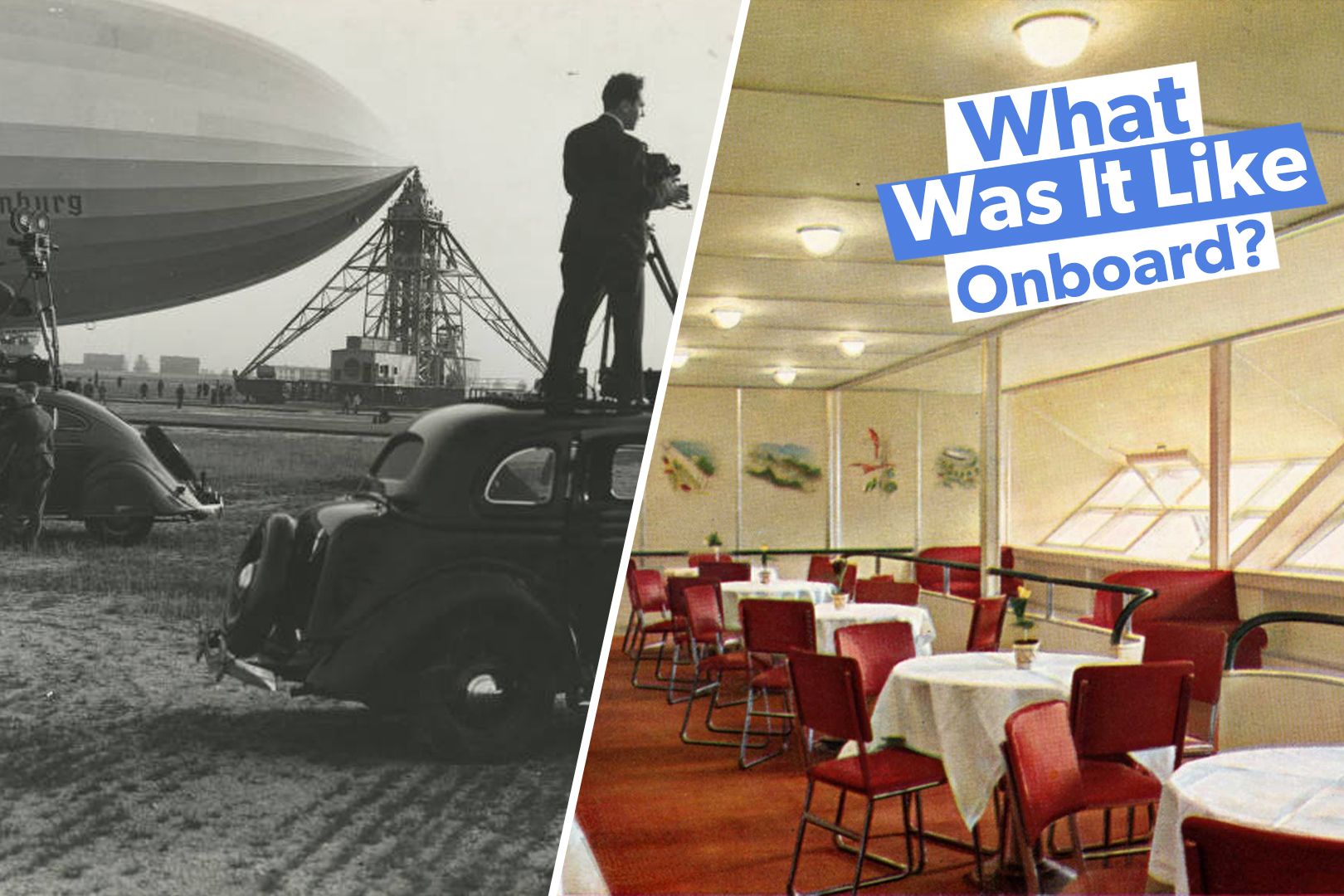Summary Zeppelin Hindenburg offered a luxurious flying experience with heating and segregated passenger areas. The passenger accommodation included cabins, dining room, lounge, smoking room, bar, and writing rooms. Hindenburg had a smoking room and bar, with cabins that resembled modern train compartments.
Traveling across the Atlantic on a Zeppelin airship was a luxurious experience reserved only for the richest of the rich. The Hindenburg cost $400 one way in 1936 and $450 in 1937. In comparison, a first class passage on a German oceanliner could cost as little as $157.

The Hindenburg had two levels, and its interior spaces could be divided into three main areas - the passenger decks, control car, and crew areas. One of Hindenburg's most notable passengers was the remarkable aviation pioneer Clara Adams (who purchased a new Zeppelin ticket the day after the disaster). A big improvement from the Graf Zeppelin The Hindenburg's passenger accommodation was located in the airship's hull (a change from the earlier Graf Zeppelin, where the passenger space was in the airship's gondola).
Passenger space was located on two decks called A Deck and B Deck. A Deck hosted the airship's dining room, lounge, writing room, port and starboard promenades, and some 25 double-berth inside cabins. Passenger accommodation on the Hindenburg was a massive improvement over the earlier Graf Zeppelin (which was infamous for being unheated, forcing passengers to rug up warmly).
By contrast, passenger areas on the Hindenburg were heated. The heated air was obtained by using air warmed by water from the cooling systems on the Hindenburg's forward engines. LZ 129 Hindenburg in numbers Length: 803.
8 feet Diameter: 135.1 feet Lift: 511,500 lbs Gas: Hydrogen (originally planned for helium) Cruising speed: 76 mph Deaths: 36 (out of 97 passengers and crew) Incidentally, German Zeppelins found the South American route (where there was a large German population) more popular than the Transatlantic route to the United States. The Graf Zeppelin was en route from South America back to Germany when the Hindenburg exploded (that was the last time the Graf Zeppelin flew with commercial passengers) .
The transatlantic passage of the Graf Zeppelin was a monumental development in commercial aviation overshadowed by Pan Am's flying boats. Public areas Dining Room The Dining Room on the Hindenburg stretched out along the full A Deck port site. The room was around 13 feet wide and some 47 feet long, decorated with paintings on silk wallpaper (which featured scenes of the Graf Zeppelin's flights to South America).
The Dining Room's tables and chairs were made of lightweight tubular aluminum and the chair's upholstery was red. Lounge & Writing Room Over on the starboard size of A Deck was the Passenger Lounge around 34 feet long and decorated in murals of routes and ships of famous European explorers and historic crossings. Airships.
net says these included " Ferdinand Magellan, Captain Cook, Vasco de Gama, and Christopher Columbus, the transatlantic crossing of LZ-126 (USS Los Angeles), the Round-the-World flight and South American crossings of LZ-127 Graf Zeppelin, and the North Atlantic tracks of the great German ocean liners Bremen and Europa ." Hindenburg timeline: Built: 1931–1936 First test flight: March 4, 1936 First commercial South American flight: March 31-April 4, 1936 First commercial flight to the USA: May 6-May 9, 1936 Destruction: May 6, 1937 The furniture was also made of aluminum, and the chair's upholstery was brown. Incredibly, on the 1936 voyage, the Lounge even boasted a 356-pound Bluthner baby grand piano (removed during the doomed 1937 voyage to Lakehurst).
A Writing Room was located next to the Lounge. The Germans were the first to use airships in a strategic bombing role, bombing London, Paris, and beyond. The Smoking Room Bewilderingly, the hydrogen-inflated airship featured a smoking room (and it was maybe the most popular room).
The room was kept at a higher pressure to ensure no leaking hydrogen would get into it. Cigarettes were lit by an electric lighter, as no open flames were permitted on the airship. Both the smoking room and the bar were separated from the rest of the ship by a double-door airlock.
From the room, passengers could see the view through sealed windows. The Bar The bar was a small ante-room between the smoking room and the air-lock door. Here, the Hindenburg bartender would serve cocktails and make sure no passengers left the smoking room with lit cigarettes.
Passenger Cabins The Hindenburg was built with 25 double-berthed cabins at A Deck's center. These accommodated 50 passengers during the 1936 season. After that, the Hindenburg was fitted with another 9 cabins with space for 20 more passengers in B Deck.
Hindenburg fare: $400 first season, $450 second season Passenger accommodation: 50 first season, 70 second season Passenger cabins: 25 first season, 34 second season Heating: Yes Facilities: smoking room, shower, bar, kitchen, writing room, male and female toilets Like the Graf Zeppelin, the Passenger Cabins were comparable to a modern sleeping train's compartments with upper beds that can be stowed during the day (the lower ones were fixed in place and would function as seating by day). They measured around 78 inches by 66 inches, while colors were either light blue, beige, or gray. As this was a luxury flight, each cabin had call buttons to call the stewardess or steward.
Additional features included a small fold-down desk, wash basin (with hot water), and a small closet. Male and female toilets were located on the B Deck below. B Deck also boasted a single shower whose weak stream of water was more like a soda siphon or seltzer bottle than an actual shower.
Additionally, promenades were located on either side of A Dest with large windows where passengers could enjoy the view. B Deck also contained the kitchen, and crew and officer's mess (crew areas were in the hull interior)..


















